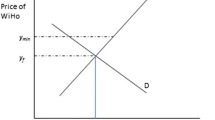Abstract
This article presents a simple conceptual framework integrating three couple-related outcomes analyzed in this volume: wage differentials in earnings related to couple formation, household formation (including cohabitation and registration as Registered Domestic Partnership), and intra-household allocation of income. It also discusses some of the articles’ main findings.
Similar content being viewed by others
Notes
For simplicity we are ignoring a third way of being in-couple: partnership without co-residence. BGM consider this third form of partnership.
One possible reason for the asymmetry is that wage consequences of coupling are more quantifiable than consequences in the area of individual consumption.
The terms ‘principal household worker’ and ‘principal earner’ were first used in Bonke and Grossbard (2008).
We thank Christopher Jepsen for calculating Census statistics and Gary Gates for providing further analysis of the Tobacco Survey data.
For simplicity, we choose 2% because it is in kee** with several studies, including the National Survey of Family Growth and the California Health Interview Survey. The Census does not include questions about sexual orientation.
This is likely to be an underestimate of the true cohabitation rate among heterosexuals.
References
Apps, P., & Rees, R. (1997). Collective labor supply and household production. Journal of Political Economy, 105(1), 178–190.
Becker, G. (1973). A theory of marriage: Part I. Journal of Political Economy, 81(4), 813–846.
Becker, G. (1974). A theory of marriage: Part II. Journal of Political Economy, 82(2), S11–S26.
Becker, G. (1981). A treatise on the family. Cambridge: Harvard University Press.
Benham, L. (1974). Benefits of women’s education within marriage. In T. W. Schultz (Ed.), Economics of the family: Marriage, children, and human capital. Chicago: The University of Chicago Press.
Black, D., Sanders, S., & Taylor, L. (2002). Why do gay men live in San Francisco? Journal of Urban Economics, 51(1), 54–76.
Black, D., Sanders, S., & Taylor, L. (2007). The economics of lesbian and gay families. Journal of Economic Perspectives, 21(2), 53–70.
Bonke, J., & Grossbard, S. (2008). Complete income pooling and quasi-wages for household producers. Paper presented at the Workshop on the Labor Market Behavior of Couples, Nice, June.
Browning, M., Bourguignon, F., Chiappori, P., & Lechene, V. (1994). Income and outcomes: A structural model of intra-household allocation. Journal of Political Economy, 102(6), 1067–1096.
Cohen, P. (1999). Racial-ethnic and gender differences in returns to cohabitation and marriage: Evidence from the Current Population Survey. Population Division Working Paper No. 35. Population Division, U.S. Bureau of the Census.
Daniel, K. (1992). Does marriage make men more productive? Mimeo, University of Chicago.
Gates, G., Badgett, M. V. L., & Ho, D. (2008). Marriage, registration and dissolution by same-sex couples in the US. Report by The Williams Institute, July.
Grossbard-Shechtman, A. (1984). A theory of allocation of time in markets for labor and marriage. Economic Journal, 94(376), 863–882.
Grossbard-Shechtman, S. (1993). On the economics of marriage: A theory of marriage, labor, and divorce. Boulder, Co.: Westview Press.
Grossbard-Shechtman, S. (2001). The new home economics at columbia and chicago. Feminist Economics, 7(3), 103–130.
Grossbard-Shechtman, A., & Neuman, S. (1991). Cross-productivity effects of education and origin on earnings: Are they really reflecting productivity? In J. Gerber, R. Frantz, & H. Singh (Eds.), Handbook of behavioral economics, Vol II. Greenwich: JAI Press.
Grossbard-Shechtman, S., & Neuman, S. (2003). Marriage and work for pay. In S. Grossbard-Shechtman (Ed.), Marriage and the economy: Theory and evidence from advanced industrial societies. New York and Cambridge: Cambridge University Press.
Jepsen, L. (2005). The relationship between wife’s education and husband’s earnings: Evidence from 1960 to 2000. Review of Economics of the Household, 3(2), 197–214.
Jepsen, L., & Jepsen, C. (2002). An empirical analysis of the matching patterns of same-sex and opposite-sex couples. Demography, 39(3), 435–453.
Leppel, K. (2007a). Home-ownership among opposite- and same-sex couples in the US. Feminist Economics, 13(1), 1–30.
Leppel, K. (2007b). Married and unmarried, opposite- and same-sex couples: A decomposition of homeownership differences. Journal of Housing Research, 16(1), 61–81.
Lundberg, S., & Pollak, R. (1996). Bargaining and distribution in marriage. Journal of Economic Perspectives, 10(4), 139–158.
McElroy, M., & Horney, M. J. (1981). Nash bargained household decisions: Toward a generalization of the theory of demand. International Economic Review, 22(2), 333–349.
Mincy, R., Grossbard, S., & Huang, C. (2005). An economic analysis of co-parenting choices: Single parent, visiting father, cohabitation, marriage. Working paper, March.
Rothblum, E. D. (forthcoming 2009). An overview of same-sex couples in relationships: A research area still at sea. In D. A. Hope (Ed.), Contemporary perspectives on lesbian, gay and bisexual identities. Volume 54 of the Nebraska Symposium on Motivation. NY: Springer.
Smock, P. J., Manning, W., & Porter, M. (2005). Everything's there except money: How money shapes decisions to marry among cohabitors. Journal of Marriage and Family, 67(3), 680–696.
Acknowledgments
We thank Jens Bonke, Kitt Carpenter, Gary Gates, John Graham, and Howard Yourow for helpful comments.
Author information
Authors and Affiliations
Corresponding author
Rights and permissions
About this article
Cite this article
Grossbard, S., Jepsen, L.K. The economics of gay and lesbian couples: Introduction to a special issue on gay and lesbian households. Rev Econ Household 6, 311–325 (2008). https://doi.org/10.1007/s11150-008-9043-4
Received:
Accepted:
Published:
Issue Date:
DOI: https://doi.org/10.1007/s11150-008-9043-4



